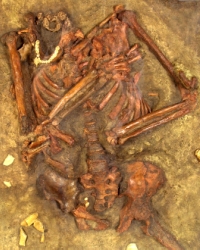Neanderthals (Homo neanderthalensis)
Neanderthals began to evolve about 400,000 years ago, and survived in Europe and Asia until around 39,000 years ago. Meanwhile modern humans (Homo sapiens) were evolving in Africa.
Thanks to an abundance of fossil evidence, we have a good idea of what Neanderthals probably looked like. The animation above shows a typical Neanderthal man. His large nose and strong double-arched brow ridge distinguish him from a modern human.
If you have a webcam, you can also watch an augmented reality Neanderthal walking around your room.
Who were the Neanderthals?

Illustration of a Neanderthal woman. © John Sibbick / Natural History Museum
Hundreds of Neanderthal fossils have been found since the first identified in 1856 in the Neander Valley, Germany, allowing us to build up an almost complete picture of a typical Neanderthal body.
They had large brains and short, stocky physiques suited to living in cold environments. Their big nose was also adapted to warming and humidifying the air.
Neanderthals were skilled hunter-gatherers, made and used flint and stone tools, built shelters and controlled fire. They were highly carnivorous but they also ate other foods, although only limited evidence of plant foods survives in the archaeological record. In Mediterranean regions the Neanderthals exploited marine resources such as shellfish and seals, but their use of aquatic foods was certainly more limited than that of modern humans.
Neanderthals behaved strikingly like our own species in some ways. As well as making and wearing clothes and probably also simple jewellery, archaeological evidence also suggests that they buried their dead.
A close relative

Neanderthal burial site at Kebara, Israel. Some scientists believe that such sites suggest that Neanderthals honoured their dead.
Fossil and genetic data suggest that Neanderthals shared a common ancestor with our species around 400,000 years ago, thought by many scientists to be Homo heidelbergensis.
In 2010, most of the Neanderthal genome was mapped and compared to modern populations of Homo sapiens, revealing that the Neanderthals' relationship to some modern humans was even closer than previously thought. The results showed that people in Europe, Asia and New Guinea have around 2.5% Neanderthal DNA in their genetic code, suggesting Neanderthals interbred with modern humans not long after they spread out of Africa.
Why did the Neanderthals die out?
All physical evidence of the Neanderthals disappears around 39,000 years ago. Modern humans reached Europe around 6,000 years earlier and it has been suggested that superior brains, language and skills allowed them to prevail over the Neanderthals. However, this may underestimate our relative.
An alternative view suggests that Ice Age climate fluctuations affected European flora and fauna, causing the disappearance of familiar plants and animals, and that modern humans were better able to adapt than Neanderthals.